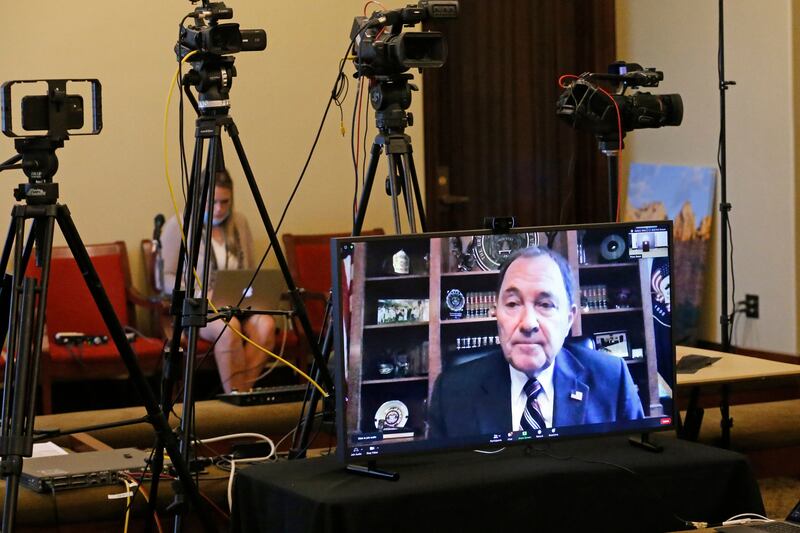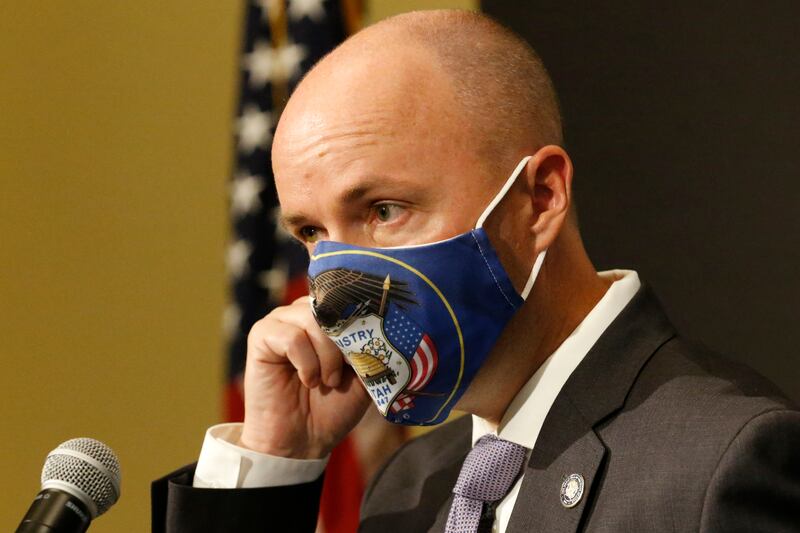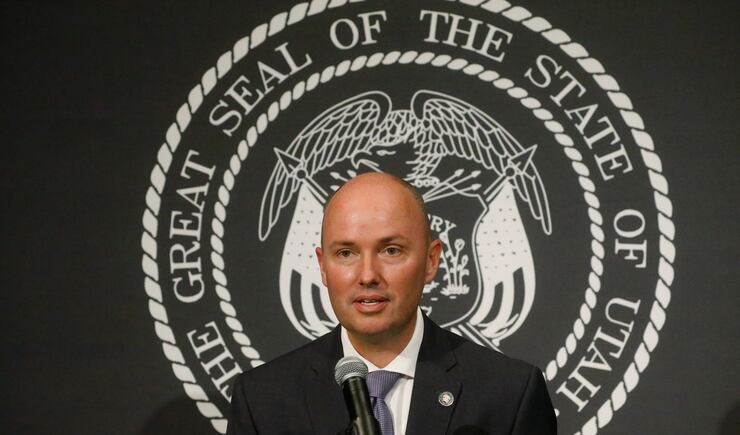SALT LAKE CITY — The day after Gov. Gary Herbert acknowledged a “dramatic” increase in COVID-19 cases, the Utah Department of Health announced even more sobering numbers.
In fact, Thursday’s 590 new cases mark the third-highest, single-day total since the outbreak began in March. Additionally, there were also 34 new hospitalizations reported, which means 170 Utahns are currently hospitalized. One more COVID-19 fatality was also reported.
Late Thursday, a spokeswoman for the governor’s office said Herbert had approved requests from Salt Lake County and Summit County to require that masks be worn in public in those two counties.
“Notifications are in the process of being made to the two requesting jurisdictions that they may implement a face-covering requirement. Gov. Herbert has approved their requests,” spokeswoman Brooke Scheffler said.
Herbert had promised Wednesday to make a decision Thursday, and multiple communications from his office throughout the day said a decision was forthcoming. Then late Thursday afternoon, his office said no decision would be announced until Friday afternoon.
Salt Lake County Mayor Jenny Wilson earlier Thursday evening had expressed disappointment that a decision wasn’t to be made until Friday.
“Look, there’s a sense of urgency in the community,” Wilson told the Deseret News. “We need elected officials and leaders to lead right now. And I feel very strongly that ... everything is pointing to a need for more dramatic action within our community.”
She pointed to a 40% increase in COVID-19 cases since June 1, from about 5,900 cases to nearly 10,000 cases.
“We know that wearing face masks makes a difference,” she said.
Then Scheffler sent a text just before 7 p.m. about the decision but said no press release or other information about Herbert’s permission would be released.
Wilson, who learned about Herbert’s decision from the media, said she was “happy” the governor acted.
“I believe it’s the right move,” she said. “If I didn’t believe that, we wouldn’t have asked. I appreciate he did stay true to his comment to honor local government, and we see a need in our community.”
Wilson said she couldn’t speak to the process of Herbert’s decision after the earlier indication an announcement wouldn’t come until Friday. “What I care about,” the mayor said, “is being able to move forward.”
“These are really critical times and these are tough decisions, but I will do everything I can as mayor to protect the health and safety of the residents of this county,” Wilson said. “If we as a community make a commitment to action now, we can buck this trend and we can move this in the right direction. I’m glad the governor understands that.”
The request was made Tuesday to mandate masks in “retail and commercial establishments” beginning this weekend in Salt Lake County. Summit County officials filed a request to do the same on Thursday in their county.
Under legislation passed by the Utah Legislature earlier this year, local governments must seek permission from the governor to enact any additional COVID-19 restrictions that are more strict than the governor’s statewide orders.
Wilson plans to implement the Salt Lake County face coverings requirement beginning at 12:01 a.m. Saturday. She said she hopes that “when I go into a local grocery store in the next day or two, we’re seeing a higher rate of acceptance of wearing face coverings.”
After word of Herbert’s approval, Wilson said county officials will write the specific health order’s language and issue it Friday. She said it would not mandate residents to wear masks while recreating outside or in parks, but they would be required in retail or commercial establishments, at restaurants while waiting to be seated and served, and at community gatherings.
Salt Lake City Mayor Erin Mendenhall, who had voiced her support for the county mayor’s request, thanked Herbert for the decision on Twitter Thursday evening.
“I’m thankful to @GovHerbert for his decision today. Masks are a key to turning the rising number of COVID cases around. Protect yourself, your loved ones and your communities by wearing one,” she wrote.
Wilson’s written request Tuesday was supported by Gary Edwards, executive director of the Salt Lake County Health Department, who cited studies that said face coverings reduce transmission risks from 75% to 82%, and he called it the “most effective method for reducing transmission.” He also said wearing masks was the “least intrusive” way to battle the outbreak.

“We can still work, socialize and conduct daily tasks with minimal inconvenience or effort,” Edwards wrote in the request to the governor.
Herbert hinted Wednesday the decision was almost a foregone conclusion because he’s a “local control guy.”
“I believe that those closest to the people are in that local government arena, and what’s best for them and their community at large,” he said. “And so I would expect if the data proves out the request ... we will grant their request for them to be able to make it a mandatory requirement to wear a face mask in Salt Lake County.”
Mask wearing has become a politicized issue. Critics say the government can’t and shouldn’t impinge on their freedom by requiring them to don a face covering. But to Wilson, it shouldn’t be political. She compared it to requiring seat belts, or shirts and shoes in private establishments.
“This is a critical health crisis,” Wilson said, “and further action is needed to turn the tide in the right direction.”
The death reported Thursday was a Salt Lake County man between the ages of 45 and 64 who was not hospitalized at the time of his death. The state has recorded 164 deaths from the novel coronavirus during this year’s pandemic.
The health department reported 7,316 tests, but officials said it may be “artificially high due to several days of negative (test) results being reported today.”

Among those calling on Herbert to grant the mask mandate requests from county officials were legislators who represent communities disproportionately impacted by the COVID-19 outbreak.
“We are truly still in a crisis,” said Sen. Luz Escamilla. She and Sen. Jani Iwamoto and Reps. Sandra Hollins, Angela Romero, Karen Kwan and Mark Wheatley have continued to coordinate with public health officials using $1 million in Coronavirus Aid, Relief and Economic Security Act funds they secured through the state to advocate for actions to improve outcomes for communities of color who have been hit hardest by the coronavirus pandemic. They created the COVID-19 community partnership to help address the needs of communities that felt overlooked by the state’s initial response.
Since launching on May 9, the partnership, which connected health officials with community groups serving the hardest-hit communities, administered 3,004 tests through targeted mobile testing events to patients from Carbon, Davis, Duchesne, Salt Lake, Tooele, Summit, Utah, Wasatch and Weber counties. Of those tested, 11.8% tested positive.
“The increasing rate of COVID-19 case numbers day after day is frightening, and it poses a real and significant threat to the health and safety of all Utahns,” said Escamilla, who has recovered from COVID-19. “The heroic work of the neighborhood community health workers and our public health partners remains critical for Utah’s communities of color during this very difficult time. The work must continue. We are not stopping. We will get through this.”
Case rates for ethnic and racial minority groups, including Native Hawaiian/Pacific Islanders, Hispanic or Latinos, Black/African Americans, and American Indian/Alaska Natives, continue to be disproportionately higher than the larger, nonminority community.
The hardest-hit community is Latino/Hispanic, a speaker in Herbert’s Spanish language press briefing said Thursday. They make up 14.2% of Utah’s population, but they make up more than 42% of the state’s cases.
One reason cited for higher numbers among Latino/Hispanic Utahns is that many work essential jobs or have jobs that don’t allow them to work from home. Summit County’s biggest city, Park City, relies heavily on a workforce that includes a large number of Hispanic employees.
In its plea to state health department officials, Summit County officials note that they only have four ICU beds in the entire county.
“The proportion of our positive cases related to travel has steadily increased from 0% on Memorial Day to 13% today,” the letter states. “We have had nine consecutive days of increased (incidence) cases, based on the CDC three-day average methodology. ... Our business community and resort community simply cannot endure a return to moderate risk (orange) without suffering catastrophic economic damage. We need an expedient solution.”

They requested that a mandatory mask rule be implemented immediately, as “our community cannot afford to ‘wait and see.’” The letter said the move is supported by the Park City Chamber of Commerce.
The rationale used by Summit County to seek the mandatory mask requirement is similar to the plea Herbert made with residents in asking them to voluntarily comply. He suggested that everyone wearing masks is a simple way to keep businesses open and the economy recovering. And economic issues have been even more profound for those ethnic groups harder hit with illness.
“With state efforts to reopen economic activity also accelerating the spread of COVID-19, it is more critical than ever to ensure that no population is left behind,” said Romero.
Officials hoped Thursday’s Spanish press briefing would reach people who have been disproportionately impacted by the COVID-19 outbreaks.
The briefing covered everything from what precautions should be taken to prevent the spread of the virus to where to get tested and what to do if a person feels unsafe at work. It featured a brief opening statement from Herbert, and then information from Cox. Also speaking were Dr. Tamara Moores Todd, Intermountain Healthcare; Mayra Cedano, multicultural subcommittee member of Comunidades Unidas; and Cameron Ruppe, Utah Occupational Safety and Health.



Among the issues that create barriers for those groups suffering disproportionately high numbers in getting accurate information or services are access to computers and technology, food insecurity, misinformation, housing issues, access to health care, language barriers, fear of repercussions or deportation, landlord/tenant issues, and access to emergency services.
Cedano said the main message from Comunidades Unidas is that they shouldn’t be afraid to seek the services they need as there is a wide network of groups and government agencies that will help them with any issues they’re encountering during the pandemic.
“Our main reason why we’re here is to let our immigrant community know that this is going to be a work for all of us, and that it is important for them to seek the services that they need,” Cedano said. “Another important message that we delivered was that there are services available for immigrants, regardless of their immigration status.”






